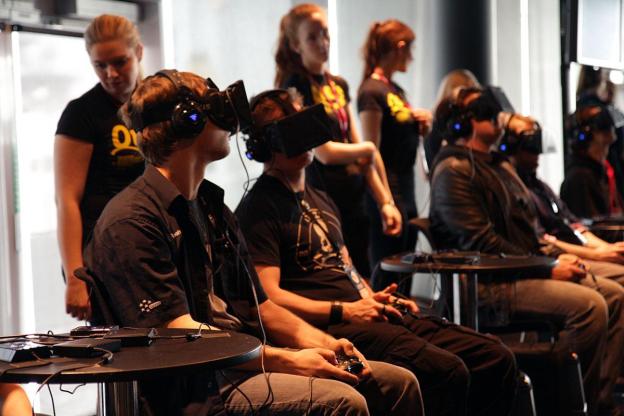
I have seen the future, and it was through the eyes of another. In the time since id Software’s John Carmack first started showing off an early version of Palmer Luckey’s Oculus Rift VR headset back in 2011, creative thinkers in the interactive space have been mulling over their next steps. The recent post-Kickstarter release of the Rift developer kit creates an opportunity for those ideas to take shape, and we’ve seen everything from pure tech demos to headset-friendly unofficial patches to existing games like Mirror’s Edge and Team Fortress 2. EVR is the next logical step in the hardware’s progression.

CCP gave fans and press alike an opportunity to spend a few minutes having their minds blown in what amounts to a competitive dogfighting space sim built with EVE Online assets. There isn’t enough here to qualify it as a full-blown game – yet – but it is sheer brilliance as a demonstration of the tech, and compelling evidence that Luckey’s creation is more than just a gimmick.
Your EVR experience begins in a launch tube not unlike those that propel Battlestar Galactica‘s Vipers into space. It’s a convincing illusion once you’ve got the headset positioned correctly. Crane your neck to look around and you’ll clearly see where the cockpit glass ends and the ship’s metal hull begins. You’ll see purely cosmetic control readouts arrayed out in front of you. Most jarringly, you’ll see your own digital legs extending out from the pilot’s chair, and your own sort of-hands gripping a pair of joystick controls.
It’s not 100-percent perfect, mind you. Try to wiggle your fingers and you won’t see a similar response in the game. EVR is controlled with an Xbox 360 controller; while it’s certainly possible to create animated body movements and tie them to controller inputs, it’s just not there in this tech demo. Leaning forward for a closer look at the ship’s monitors is similarly illusion-breaking, and is also a fixable problem. The important thing to remember here: it works.

A match begins with all 12 player-controlled fighters launching from their individual tubes, six to a side. The acceleration and ejection into space is a dazzling experience. You may not feel the actual Gs pressing down on your body, but so convincing is the immersion that there’s a reflexive push back into your seat. The moment that the ship soars free into open space leaves you breathless.
It is the product of seven weeks of work, all of it put in during off-hours. And it is an electrifying experience.
Holding down the left trigger brings up a gray reticule in the center of your screen. It stays locked in that position as you move your head around, effectively turning your eyes into a makeshift targeting computer. Get an enemy fighter in your crosshairs for a few moments and you’ll hear a high-pitched one. Let go of the trigger here and watch in delight as a cluster of missiles fly of toward your marked target.

This is a simple framework. There’s no energy meter or defined payload limiting your attack capabilities, no clear score readout or respawn cap. Nothing that offers any sense of long-term investment. EVR is immediate. It’s an arcade game. It might as well be Combat on the Atari 2600. You are plunged into a frantic ship battle for a few short minutes. You fly and you fight until you can’t anymore, at which point the game names a winning team. Simple.

We are not likely to see EVR anytime soon in an official capacity. The Oculus Rift itself is more than a year out from its consumer release, for starters. Then there’s the game, which remains more in the proof-of-concept space for the time being. That concept though… it is something else. And it’s a work-in-progress. No one at CCP views EVR as “finished.”
We’ll have more for you this week from one of the devs on this ambitious project, and more in general from the now-concluded EVE FanFest 2013. You can keep up with all of it right here.


